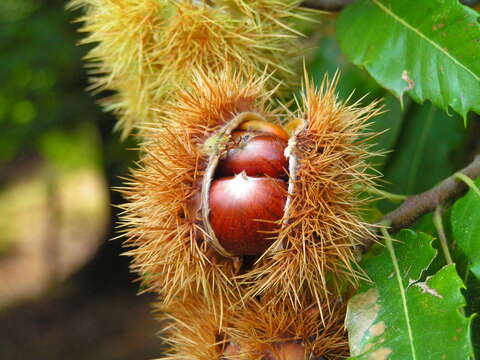Frucht der Edelkastanie

Description:
Description: Castanea sativa Deutsch: Frucht der Edelkastanie. (Castanea sativa) English: The Sweet Chestnut is a tree (Castanea sativa, family Fagaceae) native to southern Europe and Asia Minor. It is often a large tree attaining a height of 20–35 m with a trunk often 2 m in diameter. The oblong-lanceolate, boldly toothed leaves are 16–28 cm long and 5–9 cm broad. The flowers of both sexes are borne in 10–20 cm long, upright catkins, the male flowers in the upper part and female flowers in the lower part. They appear in late June to July, and by autumn, the female flowers develop into spiny cupules containing 3–7 brownish nuts that are shed during October. Español: Castañas. (Castanea sativa) Français : Une bogue découvrant ses châtaignes (Castanea sativa) Italiano: Castagne. (Castanea sativa). Date: 4 October 2004 (according to Exif data). Source: Own work. Author: Benjamin Gimmel, BenHur. Permission(Reusing this file): I, the copyright holder of this work, hereby publish it under the following licenses: : Permission is granted to copy, distribute and/or modify this document under the terms of the GNU Free Documentation License, Version 1.2 or any later version published by the Free Software Foundation; with no Invariant Sections, no Front-Cover Texts, and no Back-Cover Texts. A copy of the license is included in the section entitled GNU Free Documentation License.http://www.gnu.org/copyleft/fdl.htmlGFDLGNU Free Documentation Licensetruetrue. : This file is licensed under the Creative Commons Attribution-Share Alike 3.0 Unported license. :. You are free: to share – to copy, distribute and transmit the work to remix – to adapt the work Under the following conditions: attribution – You must give appropriate credit, provide a link to the license, and indicate if changes were made. You may do so in any reasonable manner, but not in any way that suggests the licensor endorses you or your use. share alike – If you remix, transform, or build upon the material, you must distribute your contributions under the same or compatible license as the original. This licensing tag was added to this file as part of the GFDL licensing update.http://creativecommons.org/licenses/by-sa/3.0/CC-BY-SA-3.0Creative Commons Attribution-Share Alike 3.0truetrue. : This file is licensed under the Creative Commons Attribution-Share Alike 2.5 Generic, 2.0 Generic and 1.0 Generic license. :. You are free: to share – to copy, distribute and transmit the work to remix – to adapt the work Under the following conditions: attribution – You must give appropriate credit, provide a link to the license, and indicate if changes were made. You may do so in any reasonable manner, but not in any way that suggests the licensor endorses you or your use. share alike – If you remix, transform, or build upon the material, you must distribute your contributions under the same or compatible license as the original. https://creativecommons.org/licenses/by-sa/2.5 CC BY-SA 2.5 Creative Commons Attribution-Share Alike 2.5 truetrue. You may select the license of your choice..mw-parser-output.template-picture-of-the-day{clear:both;width:100%;margin:0.5em auto;border:2px solid #e5d4a1;background-color:#faf5e6;border-spacing:8px}.mw-parser-output.template-picture-of-the-day td{padding:0}.mw-parser-output.template-picture-of-the-day.potd-icon{width:64px;text-align:center} : This image was selected as picture of the day on Wikimedia Commons for 23 February 2006. It was captioned as follows:English: The Sweet Chestnut is a tree (Castanea sativa, family Fagaceae) native to southern Europe and Asia Minor. It is often a large tree attaining a height of 20-35 m with a trunk often 2 m in diameter. The oblong-lanceolate, boldly toothed leaves are 16-28 cm long and 5-9 cm broad. The flowers of both sexes are borne in 10-20 cm long, upright catkins, the male flowers in the upper part and female flowers in the lower part. They appear in late June to July, and by autumn, the female flowers develop into spiny cupules containing 3-7 brownish nuts that are shed during October. Other languages: Alemannisch : Walnuss (Castanea sativa)Čeština : Kaštanovník jedlý (Castanea sativa)Deutsch: Castanea sativa Mill.English: The Sweet Chestnut is a tree (Castanea sativa, family Fagaceae) native to southern Europe and Asia Minor. It is often a large tree attaining a height of 20-35 m with a trunk often 2 m in diameter. The oblong-lanceolate, boldly toothed leaves are 16-28 cm long and 5-9 cm broad. The flowers of both sexes are borne in 10-20 cm long, upright catkins, the male flowers in the upper part and female flowers in the lower part. They appear in late June to July, and by autumn, the female flowers develop into spiny cupules containing 3-7 brownish nuts that are shed during October.Español : Castañas (Castanea sativa)Français : Une bogue découvrant ses châtaignes (Castanea sativa)Galego : Castañas (Castanea sativa)Italiano : Castagne (Castanea sativa)Latina : Castaneae (Castanea sativa)Magyar : Szelídgesztenye (Castanea sativa)Polski: Kasztan jadalny (Castanea sativa)Português : Castanea sativaSlovenščina : Navadni kostanj (Castanea sativa)Русский : Плод благородного каштана (Castanea sativa).Српски / srpski : Кестен (Castanea sativa)ગુજરાતી : ચેસ્ટનટ한국어: 유럽밤나무(학명: Castanea sativa Mill.)의 열매日本語: クリ (Castanea sativa)中文: 栗子 (Castanea sativa). FreePiP (Free Pictures Project)
Included On The Following Pages:
- Life (creatures)
- Cellular (cellular organisms)
- Eukaryota (eukaryotes)
- Archaeplastida (plants)
- Chloroplastida (green plants)
- Streptophyta
- Embryophytes
- Tracheophyta (ferns)
- Spermatophytes (seed plants)
- Angiosperms (Dicotyledons)
- Eudicots
- Superrosids
- Rosids
- Fagales
- Fagaceae (beech family)
- Castanea (chinquapin)
- Castanea sativa (Sweet Chestnut)
This image is not featured in any collections.
Source Information
- license
- cc-by-sa-3.0
- copyright
- Benjamin Gimmel,
- creator
- Benjamin Gimmel,
- original
- original media file
- visit source
- partner site
- Wikimedia Commons
- ID


